Classification, Morphology, Anatomy, Digestive system, Respiratory System, Circulatory system, Nervous System, Excretory System, Reproductive System - Cockroach (Periplaneta americana) | 11th Zoology : Chapter 4 : Organ and Organ Systems in Animals
Chapter: 11th Zoology : Chapter 4 : Organ and Organ Systems in Animals
Cockroach (Periplaneta americana)
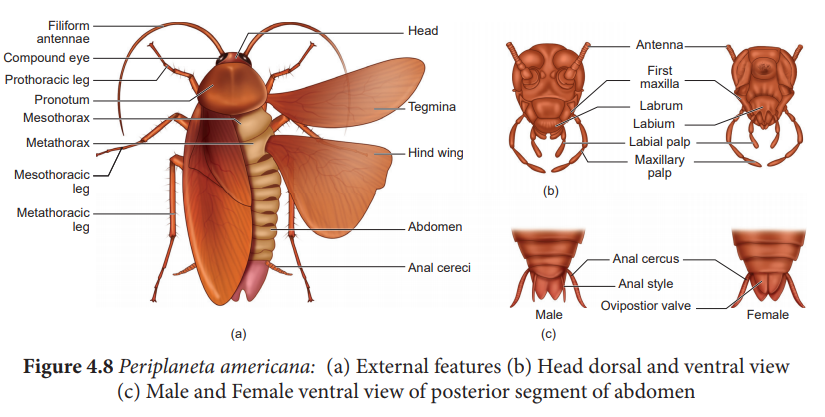
Cockroach -Periplaneta americana
Cockroach is a typical cosmopolitan insect and exhibits all the fundamental characteristics of Class Insecta. Generally cockroaches are reddish brown or black bodied with a light brown margin in the first thoracic segment. They are omnivores, nocturnal, living in damp and warm places and are quite common in kitchens, hotels, bakeries, restaurants, warehouse, sewage and public places.Periplaneta is a cursorial (swift runner) animal. It is dioecious and oviparous and exhibits parental care. They carry with them harmful germs of various bacterial diseases like cholera, diarrhoea, tuberculosis, and typhoid and hence are known as “Vectors”.
Classification
Phylum : Arthropoda
Class : Insecta
Order : Orthoptera
Genus : Periplaneta
Species : Americana
Morphology
The adult cockroaches are about 2 to 4 cm in length and about 1cm in width. The body of the cockroach is compressed dorso-ventrally, bilaterally symmetrical, segmented and is divisible into three distinct regions – head, thorax and abdomen.
The entire body is covered by a hard, brown coloured, chitinous exoskeleton. In each segment, exoskeleton has hardened plates calledsclerites, which are joined together by a delicate and elastic articular membrane or arthrodial membrane. The sclerites of the dorsal side are called tergites, those on the ventral side are called sternites and those of lateral sides are called pleurites.
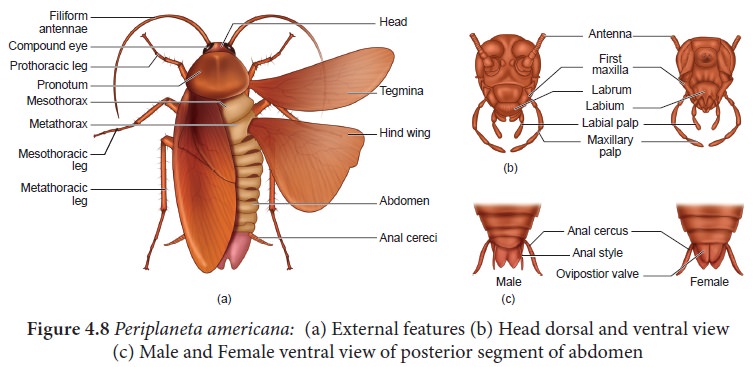
The head of cockroach is small, triangular lies at right angle to the longitudinal body axis. the mouth parts are directed downwards so it is hypognathous. It is formed by the fusion of six segments and shows great mobility in all directions due to a flexible neck (Figure 4.8). The head capsule bears a pair of large, sessile, and reniform compound eyes, a pair of antennae and appendages around the mouth. Antennae have sensory receptors that help in monitoring the environment. The appendages form the mouth parts which are of biting and chewing type (Mandibulate or Orthopterus type). The mouth parts consist of a labrum (upper lip), a pair of mandibles, a pair of maxillae, a labium (lower lip) and a hypopharynx (tongue) or lingua (Figure 4.9). The thorax consists of three segments –Prothorax, Mesothorax and Metathorax. The prothoracic segment is the largest. The head is connected with thorax by a short extension of the prothorax called as the neck or cervicum. Each thoracic segment bears a pair of walking legs. Due to th e presence of three pairs of walking legs it is also called hexapoda (hexa-six, poda-feet) All the three pairs of walking legs are similar and each leg consists of five segments – coxa (large), trochanter (small), femur (long and broad), tibia (long and thick) and tarsus. The last segment of the leg - tarsus has five movable joints or podomeres or tarsomeres. Cockroach has two pairs of wings, the first pair arises from mesothorax and protectsthe hind wings when at rest, and is called elytra or tegmina. The second pair of wings arises from the metathorax and are used in flight. The abdomen in both male and female consists of 10 segments. Each segment is covered by the dorsal tergum, the ventral sternum and between them a narrow membranous pleuron on each side. In females, the 7th sternum is boat shaped and together with the 8th and 9th sterna forms a brood or genital pouch whose anterior parts contains female gonopore, spermathecal pores, collaterial glands and posterior parts constitutes the oothecal chamber in which the cocoons are formed. In males, the genital pouch lies at the hind end of the abdomen bound dorsally by 9th and 10th terga and ventrally by the 9th sternum. It contains the dorsal anus and ventral male genital pore. In both the sexes, genital apertures are surrounded by sclerites calledgonapophysis. Male bears a pair of short and slender anal styles in the 9th sternum which are absent in the female. In both sexes, the 10th segment bears a pair of jointed filamentous structures called anal cerci and bears a sense organ that is receptive to vibrations in air and land. The 7th sternum of male has a pair of large and oval apical lobes or gynovalvular plates which form a keel like structure which distinguishes the male from the female.
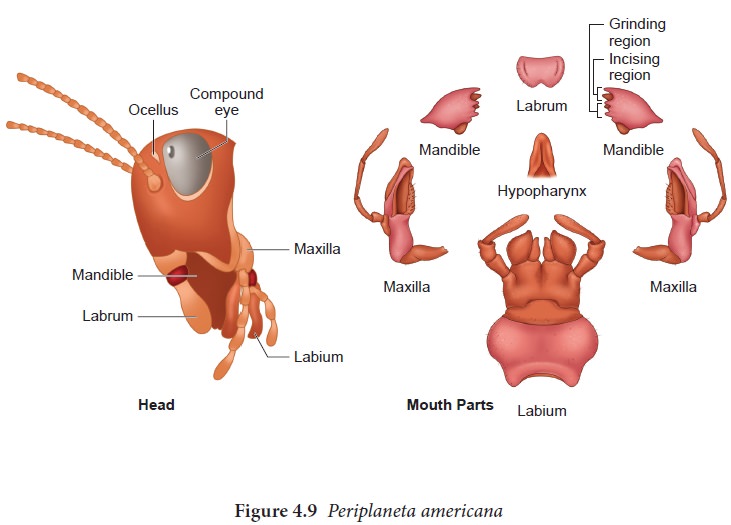
Anatomy
Digestive system
The digestive system of cockroach consists of the alimentary canal and digestive glands. The alimentary canal is present in the body cavity and is divided into three regions: foregut, midgut and hindgut (Figure 4.10). The foregut includes pre-oral cavity, mouth, pharynx and oesophagus. This in turn opens into a sac like structure called the crop which is used for storing food. The crop is followed by the gizzard or proventriculus which has an outer layer of thick circular muscles and thick inner cuticle forming six highly chitinous plates called “teeth” . Gizzard helps in the grinding of the food particles. The midgut is a short and narrow tube behind the gizzard and is glandular in nature. At the junctional region of the gizzard are eight fingers like tubular blind processes called the hapatic caecae or enteric caecae. The hindgut is marked by the presence of 100– 150 yellow coloured thin filamentousmalphigian tubules which are helpful in removal of the excretory products from the haemolymph. The hindgut is broader than the midgut and is differentiated into ileum, colon, and rectum. The rectum opens out through the anus.
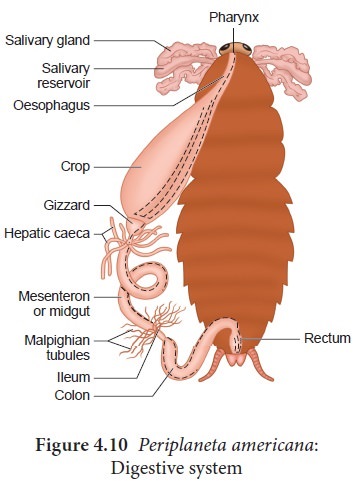
Digestive glands of cockroach consist of the salivary glands, the glandular cells and hepatic caecae. A pair of salivary glands is found on either side of the crop in the thorax. The glandular cells of the midgut and hepatic or gastric caecae produce digestive juices.
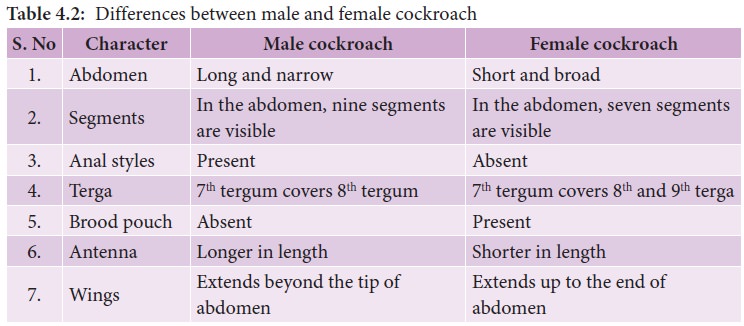
Respiratory system
The respiratory system of cockroach is well developed compared with other terrestrial insects (Figure 4.11). Branched tubes known astrachea open through 10 pairs of small holes called spiracles or stigmata, present on the lateral side of the body.
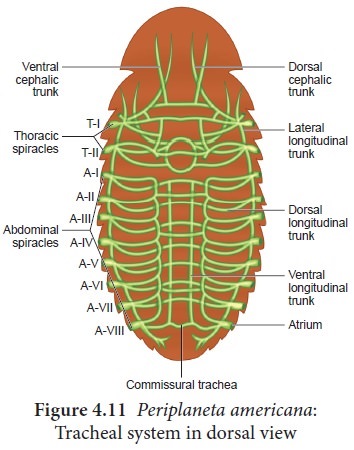
Terminal branches of tracheal tubes are called tracheoles which carry oxygen to the entire body. The spiracles open and close by valves regulated by sphincter or spiracular muscles. Each tracheole is filled with a watery fluid through which exchange of gases takes place. During high muscular activity, a part of the fluid is drawn into the tissues to enable more oxygen intake and rapid diffusion. The passage of air in the tracheal system is:

Circulatory system
Periplaneta has an open type of circulatory system (Figure 4.12) Blood vessels are poorly developed and opens into the haemocoel in which the blood or haemolymph flows freely.
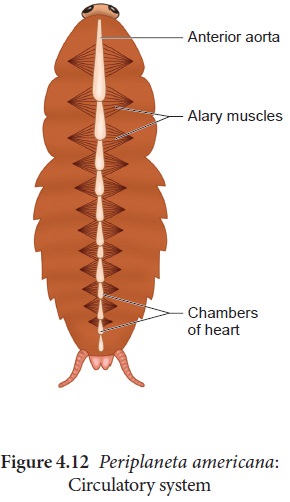
Visceral organs located in the haemocoel are bathed in blood. The haemolyph is colourless and consists of plasma and haemocytes which are ‘phagocytic’ in nature. Heart is an elongated tube with muscular wall lying mid dorsally beneath the thorax. The heart consists of 13 chambers with ostia on either side. The blood from the sinuses enters the heart through the ostia and is pumped anteriorly to sinuses again. The triangular muscles that are responsible for blood circulation in the cockroach are called alary muscles(13 pairs). One pair of these muscles is found in each segment on either side of the heart. In cockroach, there is an accessory pulsatile vesicle at the base of each antenna which also pumps blood.
Nervous system
The nervous system of cockroach consists of a nerve ring and a ganglionated double ventral nerve cord, sub-oesophageal ganglion , circum– oesophageal connectives and double ventral nerve cord (Figure 4.13). The nerve ring is present around the oesophagus in the head capsule and is formed by the supra-oesophagial ganglion called the ‘brain’, The brain is mainly a sensory and an endocrine centre and lies above the oesophagus. Sub -oesophageal ganglion is the motor centre that controls the movements of the mouth parts, legs and wings. It lies below the oesophagus and formed by the fusion of the paired gangalia of mandibular, maxillary and labial segments of the head. A pair of circum–oesophageal connectives is present around the oesophagus, connecting the supra-oesophageal ganglia with the sub-oesophageal ganglion. The double ventral nerve cord is solid, ganglionated and arises from the sub -oesophageal -ganglion and extends up to the 7th abdominal segment.
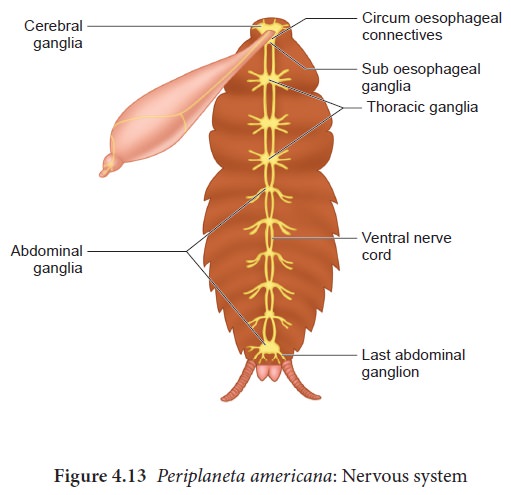
Three thoracic ganglia are present, one in each thoracic segment and six abdominal ganglia in the -abdomen.
In cockroach, the sense organs are antennae, compound eyes, labrum, -maxillary palps, labial palps and anal cerci. The receptor for touch (thigmo receptors) is located in the antenna, maxillary palps and cerci. The receptor for smell (olfactory receptors) is found on the antennae. The receptor for taste (gustatory receptors) is found on the palps of maxilla and labium. Thermoreceptors are found on the first four tarsal segments on the legs. The receptor chordotonal is found on the anal cerci which respond to air or earth borne vibrations. The photoreceptors of the cockroach consists of a pair of compound eyes at the dorsal surface of the head.
Each eye is formed of about 2000 simple eyes called the ommatidia -(singular: ommatidium), through which the cockroach can receive several images of an object. This kind of vision is known as mosaic vision with more sensitivity but less resolution.
Excretory system
The Malpighian tubules are the main excretory organs of cockroach which help in eliminating the nitrogenous wastes from the body in the form of uric acid. Cockroach excretes uric acid, so it is uricotelic. In addition, fat body, nephrocytes, cuticle, and urecose glands are also excretory in function.
The malpighian tubules are thin, long, filamentous, yellow coloured structures attached at the junction of midgut and hindgut. These are about 100-150 in number and are present in 6-9 bundles. Each tubule is lined by glandular and ciliated cells and the waste is excreted out through the hindgut. The glandular cells of the malpighian tubules absorb water, salts, and nitrogenous wastes from the haemolymph and transfer them into the lumen of the tubules. The cells of the tubules reabsorb water and certain inorganic salts. By the contraction of the tubules nitrogenous waste is pushed into the ileum, where more water is reabsorbed. It moves into the rectum and almost solid uric acid is excreted along with the faecal matter.
Reproductive system
Cockroach is dioecious or unisexual. They have well developed reproductive organs. The male reproductive system consists of a pair of testes, vasa deferentia, an ejaculatory duct, utricular gland, phallic gland and the external genitalia. A pair of three lobed testes lies on the lateral side of the 4th and 6th abdominal segments. From each testis arises a thin vas deferens, which opens into the ejaculatory duct through the seminal vesicles. The ejaculatory duct is an elongated duct which opens out by the male gonopore
A utricular or mushroom shaped gland is a large accessory reproductive gland, which opens into the anterior part of the ejaculatory duct. The seminal vesicles are present on the ventral surface of the ejaculatory duct. These sacs store the sperms in the form of bundles called spermatophores. The duct of phallic or conglobate gland also opens near the gonopore, whose function is uncertain. Surrounding the male genital opening are few chitinous and asymmetrical structures called phallomeres or gonapophyses which help in copulation.
The female reproductive system of cockroach consists of a pair of ovaries, vagina, genital pouch, collaterial glands, spermathecae and the external genitalia. A pair of ovaries lies laterally in the 2nd and 6th abdominal segment. Each ovary is formed of a group of eight ovarian tubules or ovarioles, containing a chain of developing ova. The lateral oviducts of each ovary unite into a broad median common oviduct known as vagina, which opens into the genital chamber. The vertical opening of the vagina is the female genital pore. A pair of spermathecae is present in the 6th segment, which opens by a median aperture in the dorsal wall of the genital pouch. During copulation, the ova descend to the genital chamber, where they are fertilized by the sperms. A pair of white and branched collaterial glands present behind the ovaries forms a hard egg case called Ootheca around the eggs. Genital pouch is formed by the 7th, 8th and 9th abdominal sterna. The genital pouch has two chambers, a genital chamber into which the vagina opens and an oothecal chamber where oothecae are formed. Three pairs of plate like chitinous structures called gonapophyses are present around the female genital aperture. These gonapophyses guide the ova into the ootheca as ovipositors. (Figure 4. 14).
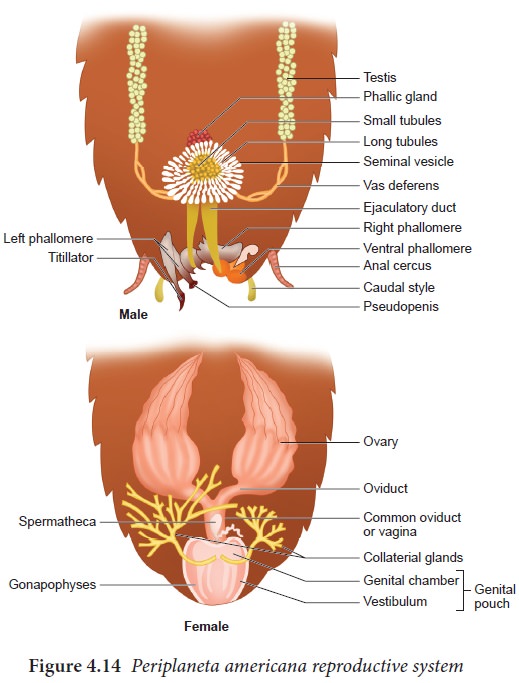
Ootheca is a dark reddish to blackish brown capsule about 12mm long which contains nearly 16 fertilized eggs and dropped or glued to a suitable surface, usually in crack or crevice of high relative humidity near a food source. On an average, each female cockroach produces nearly 15 – 40 oothecae in its life span of about one to two years. The embryonic development occurs in the ootheca, which takes nearly 5 – 13 weeks. The development of cockroach is gradual through nymphal stages (paurometabolus). The nymph resembles the adult and undergoes moulting. The nymph grows by moulting or ecdysis about 13 times to reach the adult form.
Many species of cockroaches are wild. About 30 cockroach species out of 4,600 are associated with human habitats. About four species are well known as pests. They destroy food and contaminate with their offensive odour. The mere presence of
cockroaches is a sign of unhygienic condition and they are also known to be carriers of a number of bacterial diseases. The cockroach allergen can cause asthma to sensitive people.
Related Topics